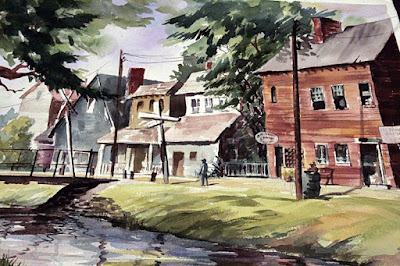Postmodernism - some key concepts
a) According to Linda Hutcheon, Postmodernity is the condition in which we now live, and it should be distinguished from Postmodernism, which refers to the cultural production and reflection that might embody its critique (the abovementioned questioning).
b) According to Fredric Jameson, Postmodernism itself belongs to the "cultural logic of late capitalism", and as such there is no distinction between the critique and the condition (the critique, obeying to the laws of the production of culture, which rest on immateriality and profit, might annull itself).
Even if Postmodernism somehow blurs the distinctions between the high and the low - the idea of equality in Postmodernism risks being overweighed by
1. Relativism: the first of the important keywords, as it is the conterpart to
2. Mistrust of grand narratives (religion, politics, scientific positivism)
3. De-differentiation (namely of economics and culture), leading to the indecidability of correspondence between value and objects, and (in language) between signifiers and possible signifieds.
4. Indifference/confusion about origin and historical chronology; not only because of doubts cast upon narratives of cause and effects, but also of the four following co-related concepts:
5. simulacrum: a term introduced by Baudrillard as leading to hyperreality ("a generation by models of a real without origin or reality) and much glossed over by Jameson, who takes it to mean an imitation of something whose original never existed.
6. a-historicism: loss of historical grounding, due not only to revisionism (interpretation of an historical fact by standards of another time) but also to the constant practice of anachronism in Postmodernity
7. pastiche: which, to Jameson, has become an inocuous and all-too clever use of mimicry, whereas Hutcheon prefers to call it
8. parody: Linda Hutcheon sees Postmodern mimicry as much more positive, a repetition that embodies transformation and difference. Whatever we call it - parody or pastiche - what we have is a radical
9. intertextuality, which is one of the many features of Postmodernism that make it a movement that doesn't exactly break with Modernism (see Diogo's comment) but radicalizes some of its practices, like:
10. Fragmentation and breakdown of linear narrative
11. Depersonalization / defamiliarization and multiple points of view
12. Variety of competitive discourses (including heteroglossia - mixing of languages within the literary text)
13. Reflexivity - we enter the consciousness of self/selves/and-or Others, and art is increasingly also reflexive of itself - it ponders on its own making. This is an important part of Postmodernism as a critique of means and ways of representation, and its awareness that realities are made rathern than given.
14. Distortion
Last - but still possibly not completely - Postmodernism includes also:
15. sexual freedom and gender b(l)ending
16. added challenges to the family as basis of society
17. nihilism and saturation of stimuli - depression / anxiety as a consequence of affective loss, and this in turn a possible consequence of skepticism (see the menace of the world's end at the click of a button at the close of World War II), as well as of the radicalization of modernist intellectualization and symbolization.
18. dislocation and evasion (where we may start with Tennessee Williams and the figure of the "fugitive"...)
b) According to Fredric Jameson, Postmodernism itself belongs to the "cultural logic of late capitalism", and as such there is no distinction between the critique and the condition (the critique, obeying to the laws of the production of culture, which rest on immateriality and profit, might annull itself).
Even if Postmodernism somehow blurs the distinctions between the high and the low - the idea of equality in Postmodernism risks being overweighed by
1. Relativism: the first of the important keywords, as it is the conterpart to
2. Mistrust of grand narratives (religion, politics, scientific positivism)
3. De-differentiation (namely of economics and culture), leading to the indecidability of correspondence between value and objects, and (in language) between signifiers and possible signifieds.
4. Indifference/confusion about origin and historical chronology; not only because of doubts cast upon narratives of cause and effects, but also of the four following co-related concepts:
5. simulacrum: a term introduced by Baudrillard as leading to hyperreality ("a generation by models of a real without origin or reality) and much glossed over by Jameson, who takes it to mean an imitation of something whose original never existed.
6. a-historicism: loss of historical grounding, due not only to revisionism (interpretation of an historical fact by standards of another time) but also to the constant practice of anachronism in Postmodernity
7. pastiche: which, to Jameson, has become an inocuous and all-too clever use of mimicry, whereas Hutcheon prefers to call it
8. parody: Linda Hutcheon sees Postmodern mimicry as much more positive, a repetition that embodies transformation and difference. Whatever we call it - parody or pastiche - what we have is a radical
9. intertextuality, which is one of the many features of Postmodernism that make it a movement that doesn't exactly break with Modernism (see Diogo's comment) but radicalizes some of its practices, like:
10. Fragmentation and breakdown of linear narrative
11. Depersonalization / defamiliarization and multiple points of view
12. Variety of competitive discourses (including heteroglossia - mixing of languages within the literary text)
13. Reflexivity - we enter the consciousness of self/selves/and-or Others, and art is increasingly also reflexive of itself - it ponders on its own making. This is an important part of Postmodernism as a critique of means and ways of representation, and its awareness that realities are made rathern than given.
14. Distortion
Last - but still possibly not completely - Postmodernism includes also:
15. sexual freedom and gender b(l)ending
16. added challenges to the family as basis of society
17. nihilism and saturation of stimuli - depression / anxiety as a consequence of affective loss, and this in turn a possible consequence of skepticism (see the menace of the world's end at the click of a button at the close of World War II), as well as of the radicalization of modernist intellectualization and symbolization.
18. dislocation and evasion (where we may start with Tennessee Williams and the figure of the "fugitive"...)


Comentários
Postar um comentário